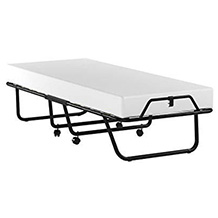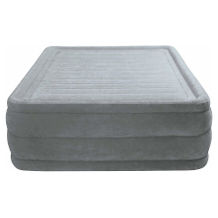Divan bed purchasing advice: how to choose the right product
- What You Need to Know
- Instead of a slatted frame, a box spring bed has a base with an innerspring core. This is followed by two more layers, consisting of a mattress and a topper.
- Thanks to the special bed system with thick padding and a springy sleeping sensation, box spring beds ensure ergonomically correct lying.
- A distinction is made between the American variant with a topper and the Scandinavian variant, which relies on a thicker top mattress instead of the topper.
- The degree of hardness of the mattress should be chosen depending on the body weight and the preferred sleeping position.
- Some box spring beds have extras such as an integrated motor, a bed base or LED lighting.
- Hand in hand with the high sleeping comfort also goes the luxurious look of these sleeping places.
Trend box spring bed – sleep like on clouds
We spend almost one third of our lives in bed. Since restful sleep is a basic prerequisite for performance in everyday life, the bed should offer all conditions for a good lying feeling as well as a high sleeping comfort. If you are looking for a suitable place to sleep today, you will hardly be able to avoid the box spring bed. The modern variant of the four-poster bed, which allows people to literally sleep on clouds, is in vogue. This is a high-quality sleeping system, which usually corresponds to a good hotel standard and promises resting people a feeling of comfort.
This type of bed differs significantly in its structure from the classic types in this country, which are usually composed of a bed frame and a combination of slatted frame (for support) and mattress (as the actual lying surface). It does without a slatted frame and instead resorts to a sprung base. On this base is the so-called box spring and – depending on the variant – a topper. Due to their special structure consisting of several layers of upholstery, boxspring beds offer a particularly high level of lying comfort.
The tradition of luxury upholstery
In Germany they are still considered a novelty, but box spring beds have been around in the USA since the beginning of the 20th century. Their developers had set themselves the goal of designing a substructure for mattresses that did not rest directly on the floor, in order to protect the sleeping surface from possible soiling. Among others, the Titanic was already equipped with the luxury beds. The stately beds have also been present in many bedrooms in Scandinavia for a long time. Initially produced as luxury beds, the gradually falling purchase price led to their growing popularity. A few years ago they were mainly found in hotels, but now they are also becoming increasingly popular in private bedrooms.
Since this type of bed is mainly represented in the American as well as in the Scandinavian region, two variants have developed, which basically differ only in the topper, respectively the mattress height. While Scandinavian box spring beds are equipped with a relatively thin topper (6 to 10 centimeters), American box spring beds, also known as Continental beds, do without this topper. Instead, they use a slightly thicker top mattress (up to 30 centimeters high) and a comparatively high headboard. However, in terms of their lying and sleeping comfort, the two variants do not differ.
Heavyweights in two respects
Boxspring beds are true heavyweights not only in the literal sense, but also in terms of price. Compared to conventional beds, they are extremely expensive. However, consumers do not necessarily have to spend several thousand euros to acquire a high-quality box spring bed. At discounters, beds with a size of 180 x 200 centimeters can already be found for less than 600 euros. However, consumers should not expect luxury in this price segment. Instead, it is usually a simple design with an inferior mattress that offers a moderate lying comfort and is very quickly worn out. For twice the amount, interested parties get box spring beds of medium quality; mattress and topper in their case are of high value. For box spring beds in the price range between 2,000 and 3,000 euros, consumers can expect all-around good workmanship, i.e. clean seams and extremely stable components. Those who pay 3,000 to 4,000 euros even receive an individual design with high-class materials. Although there are also luxury variants for more than 4,000 Euros, these expenditures are not necessary since such high prices are mainly based on the brand name and more extensive equipment. However, we recommend spending at least 1,000 euros.
Base, mattress, topper – and the sleeping system is ready.
The box spring bed takes its name from its sprung base, the box spring. What is behind the meaning can already be deduced from the word components, i.e. “box”, the English word for box, and “spring”, which means as much as springs or suspension. The secret of this type of bed lies in its special structure, more precisely in the spring box as the most important component of the system, which replaces the usual slatted frame.
Overall, a box spring bed is composed of several layers of upholstery stacked on top of each other, namely the spring box, the mattress and the topper. Depending on the model, the bed also has feet and a headboard. While the base is responsible for distributing pressure and the top mattress provides cushioning, the topper allows the bed to sink in. Depending on how consumers combine these elements, they get different degrees of hardness and flexibility. For optimal sleeping comfort, however, the mattress layers should be completely coordinated.
For a stable stand: the feet
To prevent the beds from resting directly on the floor, there are legs under the bed frame. These are usually between 5 and 20 centimeters high and adapted to the look of the bed, whether round or square, wooden or metallic, so that a coherent overall picture is created. By being firmly attached to the frame of the box spring, they provide sufficient stability. After all, they must be able to support not only the entire weight of the bed, but also the body weight of the sleeper. Due to the free space between the floor and the box, the feet ensure continuous air circulation of the box aboveMold growth is prevented.
For a sprung base: the box spring
The most important element of the bed is the box spring base, also known as the underbed or spring frame. It consists of a solid wooden or metal frame, 20 to 30 centimeters high, in which a spring core system is incorporated. This box supports the mattress and thus performs the function of a slatted frame. At the same time, it acts as the first layer of padding, which makes box spring beds appear higher and more robust than classic beds. The springy construction allows for a comfortable sinking and also prevents the formation of moisture thanks to the air circulation in the lower part of the box spring. However, since the mattress is firmly incorporated into the box, consumers cannot replace it – unlike the top mattress and topper.
For a second layer: the top mattress
The actual mattress is placed on top of the base as a second layer of padding. Consumers choose between different designs here, depending on their personal preferences. Most often, however, a barrel pocket spring core mattress is used, as it provides optimal support for the body. Just like the material, the lying properties and degree of firmness can be selected individually.
For a crowning finish: the topper
To further enhance the sleeping experience, the so-called topper is placed on top of the upper mattress (at least in the Scandinavian version). Depending on the respective bed system, this topper can be selected in different variants to match the preferred lying feeling. This flat (only five to ten centimeters thick), soft cushion, usually made of cold or visco foam, not only provides additional sleeping comfort, but also protects the mattress underneath. In addition, in the case of two individual mattresses, it covers the so-called visitor’s crevice, i.e. the gap between the mattresses.
For striking support: The headboard
Although the optional headboard is not one of the bed system’s lying elements, it rounds off the modern look of a box spring bed. Most headboards are made of high-quality solid wood that is padded and textile-covered. However, the size and shape differ depending on the model. Designs range from a simple, straightforward headboard with a modern look to a playful design with a romantic flair. If you want to make the headboard an eye-catcher, choose a generously sized version that shapes the overall look. In addition to its decorative purpose, the headboard also serves as an upholstered backrest – for example, when reading in the evening or having breakfast in bed in the morning.
Finding the right model – box spring beds for everyone?
Box spring beds come in a wide variety of designs. Since every consumer has a different body shape, different sleeping habits and different preferences, it is important to put together the bed individually. After all, sleeping is a personal matter: while one person prefers to lie hard, another prefers a soft base.
The size of the bed
When looking for a suitable model, size is an important criterion, among other things. Here, a distinction is made between the lying surface and the lying height.
The lying surface: from single to king size
The choice of lying surface depends, among other things, on the number of people sleeping in the bed, but also on the available space in your own four walls. If you are looking for a single bed, go for a box spring bed with dimensions of 80 x 200, 90 x 200, 100 x 200 or 120 x 200 centimeters. Singles in particular prefer these narrower variants. If it may also be a more generous box spring bed, for example, for couples, the sizes 140 x 200, 160 x 200, 180 x 200 or even 200 x 200 centimeters are more likely to come into question. Beds with a length or width of more than 200 centimeters are considered special sizes (also “king size” or “XXL”).
These are the common sizes at a glance:
- 90 x 200 centimeters: This very small mattress size is hardly used in a bed alone, but is mainly used by couples where the partners each have different needs.
- 120 x 200 centimeters: This single size is wide enough to allow the user to turn back and forth or change lying positions while sleeping.
- 140 x 200 centimeters: This all-rounder is designed for both singles and couples, but is mainly used by single people, as two people would have to sleep relatively close to each other.
- 160 x 200 centimeters: This standard size for couples or for singles who need space is one of the best-selling variants in Germany.
- 180 x 200 centimeters: This larger variant is perfect as a marriage bed and also ensures that both partners do not get in each other’s way.
- 200 x 200 centimeters: This king-size format offers enough space even for parents with a child.
For larger beds with a width of more than 140 centimeters, consumers can decide whether they prefer to use one continuous mattress or two individual mattresses. The advantage of two separate mattresses is that both partners can each buy a mattress according to their personal preferences, so no one has to compromise. If the partners disagree on the degree of firmness and the heat or cold properties, or if they differ greatly in terms of body weight, it is recommended in any case to purchase two separate mattresses.
The lying height: A downright royal feeling
Due to their layered construction, box spring beds are significantly higher than conventional beds. The entry height is usually between 50 and 70 centimeters (with conventional beds, on the other hand, between 45 and 60 centimeters), which makes it easy to get in and out of bed or to sit comfortably on the bed. When choosing the right bed, consumers should pay attention to the height – after all, a bed that is too high will not benefit the sleeper.
Which size is the right one depends in particular on one’s own body size. While a low height is recommended for smaller people, taller people should opt for a high mattress. People who are between 1.50 and 1.60 meters tall, for example, are well advised with a lying height of about 60 centimeters. Those taller than 1.90 meters, on the other hand, can also choose a model with a height of 70 centimeters. A height between 60 and 65 centimeters is particularly popular, as it is suitable for both small and taller people. For double beds, the height should be chosen according to the taller person. The following list summarizes all common lying heights:
- 1.50 meters: at least 50 centimeters
- 1.60 meters: at least 55 centimeters
- 1.70 meters: at least 60 centimeters
- 1.80 meters: at least 65 centimeters
- 1.90 meters: at least 70 centimeters
For the optimal height, the feet should come to the floor and not hang in the air when the person sits sideways on the bed. Especially seniors or people with joint and back problems should pay attention to an ideally fitting size to be able to get in and out comfortably without bending unnecessarily. In general, box spring beds are advantageous for older people, as in their case getting in and out of bed is much easier than with most other types of beds. However, the height of a box spring bed is less advisable for children, as they can easily fall out of bed during sleep and, moreover, getting in and out of bed could be difficult for them. The use of a box spring bed is recommended only from the age of 13 years.
The base
The base consists of a frame that is open at the bottom and incorporates an innerspring system, and serves as a base for the mattress. Here, consumers have little room for maneuver in their decision, since it is already specified that the construction must be a spring frame. However, they have a choice of different versions of this.
The spring core: Waisted, barrel-shaped or bulbous?
In terms of breathability, boxspring beds can convince all along the line, as air circulation develops inside the mattress, through which moisture escapes. This is mainly due to the spring core. In terms of the type of spring core, consumers can choose between a bonell spring core, a pocket spring core and a barrel pocket spring core:
Bonell spring core: the lowest quality
The simplest innerspring systems consist of bonell innerspring mattresses. These have ideal surface elastic properties for those who like to lie softly. That is, the springing yields more strongly over the entire surface, and when pressure is exerted, the body sinks in evenly. Bonell spring core mattresses have several waist springs, which are connected to each other by means of spiral springs on the upper and lower rings. This “endless spring system” allows the springs to react together under load, creating a swinging, soft lying sensation. The flip side of the coin is that the lack of point-elastic response makes for an overall poorer adaptation to the body. Consequently, this innerspring is only suitable for people with a low body weight (up to about 90 kilograms), as this shortcoming is not as significant in this case.
Compared to other innerspring mattresses, bonell innerspring mattresses have a small number of springs. In addition, the diameter of the head of waist springs is slightly larger, which creates larger gaps between individual springs. In order to fill these gaps or reduce the number of contact points, firm upholstery supports are used. The plus point is that, unlike other innersprings, they usually behave silently when loaded. Bonell spring cores are also particularly stable and load-bearing, as well as climate-regulating, since air can circulate freely and moisture can be wicked away.
Caution with back problems!
Due to the insufficient support or adaptation to the body, bonell spring core mattresses are less suitable for people with back problems or a misalignment of the spine. Since the chest area also yields when lying down and consumers thus sink deeper into the mattress, back pain worsens in the long run.
Pocket spring core: The somewhat better ones
Unlike bonell spring mattresses, pocket spring mattresses are not area-elastic, but point-elastic. This means that the springs only yield at certain points and thus prevent sinking. Here, the individual springs are enclosed in textile pockets. The advantage: Since the individual pockets are separated from each other, the lying surfaces can be fitted with different springs, or more precisely wire thicknesses, creating so-called lying zones. This allows the mattresses to adapt particularly well to the body, which in turn ensures a stable lying feeling. For example, the pelvis, which is generally subject to more pressure, can be supported more strongly than the more sensitive and lighter neck. The adaptation to the lying body relieves the spine. In addition, this type of innerspring mattress is suitable for all weight classes. However, pocket spring cores are especially recommended for all those who prefer a firmer lying surface or suffer from intervertebral disc or back problems.
The quality of the pocket spring mattress depends largely on the number and zoning of the springs used. The shape of the springs is reminiscent of a small barrel, as they are slightly wider in the middle than in the upper or lower part. In this respect, they are very different from the waisted bonell springs. However, just like the bonell spring mattress, this type also has very good breathing properties.
Barrel pocket spring core: The best
Barrel pocket spring cores, the further development of pocket spring cores, are generally considered to be the ultimate in box spring beds and are therefore more likely to be found in the higher price segment. Thanks to the higher number of springs, in addition to better support, there is also better point elasticity. Since they can be zoned more precisely, they can provide separate support for shoulders and hips, among other things. The core yields only in the places where there is actual stress, which provides high firmness. Thus, a barrel pocket spring mattress is recommended especially for people with back problems or other orthopedic complaints.
The bulbous springs are slightly narrower at the top and bottom, which allows for a very good spring action. Here, too, just as in the pocket spring variant, the springs are each individually sewn into fabric pockets. The fabric pockets ensure that the force of the springs is somewhat dampened, which means that they do not vibrate as much as, for example, the Bonell spring cores.
Is the number of springs decisive?
The more springs are built into the mattress, the better its punctual support or relief of the spine and thus also the sleeping comfort. Likewise, the more springs, the harder the mattress. Depending on body weight, mattresses with a very high number of springs may be perceived as too hard. If the number is too low, on the other hand, it is quicker for beds to form hollows. Box spring beds should be equipped with at least 200 springs per square meter. High-quality variants have up to 300 springs per square meter. However, a higher number is not recommended.
The box: tension plate, laminated wood or solid wood?
In addition to the type of spring core, the wood used for the frame also plays an important role. The higher the quality, the more stable or durable the material and the higher the maximum load capacity. In the case of inexpensive beds, manufacturers particularly like to save on the wood, as the frame is well hidden under the cover and thus not visible to consumers at first glance. While simple models are made of chipboard, higher quality box spring beds use glue and solid woods:
- Particleboard: inexpensive particleboard is made of coarse wood chips (a waste product) that are reglued, and is not very sturdy, but rather lightweight and unstable. Solid wood particleboard is slightly higher quality, but can by no means compete with pure solid wood.
- Plywood or laminated wood: Plywood or laminated wood consists of several thin wooden boards that are glued together and are at least 1.2 centimeters thick in total. It is significantly more robust, but also heavier (in some cases over 100 kilograms).
- Solid wood: Solid wood is the clear quality winner as the most stable and durable (but also heaviest) variant. So, if you have a sufficient budget, you should go for this type of wood. Bed frames made of solid wood are usually so robust that consumers will never have to buy a new model.
Only by using solid or solid wood can it be guaranteed that consumers will not have any problems with their box spring beds, even over a long period of time. This is because here, the bed parts are cut directly from the log and then air-dried to ensure very high stability.
The mattress
In addition to the upholstered base, the quality of the top mattress also affects sleeping comfort. Either innerspring or cold foam mattresses are used here. Which material fits best depends, among other things, on body weight and heat sensitivity.
The combination of a bonell spring core substructure and pocket spring core upper mattress provides a slightly springy lying feeling and is particularly popular with box spring beds. On the other hand, a combination of two bonell spring core mattresses, for example, makes less sense, as both elements are area-elastic, so they do not complement each other sensibly. While bonell spring core mattresses have a springing that yields very well, barrel pocket spring core mattresses have better point elasticity. Sometimes, however, cold foam mattresses are also used, which also boast high point elasticity. Here, a high density (at least RG 40, better RG 45) is advantageous, as a high foam density increases the stability of the mattress. The disadvantage of a cold foam mattress, however, is that due to the significantly lower springiness, the light lying feeling characteristic of box spring beds is not available. This type of mattress is suitable for anyone who does not value the springy behavior, but still wants an ergonomic sleeping comfort. Cold foam mattresses are also recommended for people who get cold quickly at night, because they are good heat accumulators. At the same time, moisture and body heat are transported away well.
The volume weight
The volume weight (unit: RG) refers primarily to foam mattresses and says something fundamental about their quality or longevity. The key figure indicates how many kilograms of raw mass of a synthetic material are contained in one cubic meter of foam. Mattresses with a volume weight below RG 40 have good breathability thanks to the many air pockets and pores, but they also have a lower recovery force because the material is slow to return to its original shape. Mattresses with a volume weight above RG 40, on the other hand, are more dimensionally stable. High-quality cold foam mattresses have at least RG 30, visco foam mattresses even RG 45 or 50.
The degree of firmness: body weight and sleeping position as selection criteria
Mattresses are generally available in five different degrees of firmness, but due to their springy effects, box spring beds are often only offered in two to three degrees of firmness:
| Hardness | Firmness | Maximum load capacity |
|---|---|---|
| H1 | Extra soft | Up to 60 kilograms |
| H2 | oft | 60 to 80 kilograms |
| H3 | Medium | 80 to 100 kilograms |
| H4 | hard | 100 to 120 kilograms |
| H5 | Very hard | From 120 kilograms |
However, since the degrees of firmness are not subject to any generally applicable standard, the corresponding classification of mattresses varies from manufacturer to manufacturer. The choice of the appropriate degree of firmness depends primarily on body weight, but also on personal preferences. With a higher weight it is however in any case meaningful to decide also for a higher degree of hardness so that the body does not sink too deeply and press too strongly on the base. This puts too much strain on the spine. Lighter people would hardly sink into a hard mattress, which makes the bed more of a board. In the worst case, back problems are the result. As all-rounders, H2 and H3 are among the most popular degrees of firmness.
Basically, it is not just the weight that plays a role, but rather the body mass index (BMI: body weight in kilograms divided by height in square meters):
- BMI < 25: softer mattress to H2
- BMI 25-30: H3
- BMI > 30: harder mattress from H4
However, body weight or stature is only one of many criteria according to which the degree of resistance is to be selected. The preferred sleeping position is just as relevant. People who lie primarily on their side, for example, should choose a softer firmness level so that their shoulders and hips can sink in far enough and their spine remains straight. The situation is different for back and stomach sleepers: In these cases, a firmer mattress is recommended so that the spine remains in its natural S-shape. Anatomically, no distinction is made between a firmness level for stomach and back sleepers, as the pressure on the mattress is almost identical in both positions.
However, the preferred lying position is not always maintained throughout the night. If necessary, those who frequently turn at night should reach for a model with a medium degree of firmness so that the body lies correctly in all positions.
The lying zones: For an ergonomic sleeping position
Ergonomically correct lying is very important for the spine. To ensure that the body receives support exactly where it needs it, some box spring beds are divided into so-called zones. By improving point elasticity, the mattress yields to pressure to different degrees in each case, ensuring an ideal, back-friendly sleeping position. Basically, there are three different divisions:
- 3-zone mattresses: 3-zone mattresses are slightly softer in the shoulder, lumbar and pelvic areas to support the natural shape of the spine, even in the lateral position.
- 5-zone mattresses: These mattresses stabilize the head and neck area as well as the feet, while the shoulders and pelvis sink in. Since the lumbar area also yields, even stomach sleepers lie comfortably.
- 7-zone mattresses: These mattress models adapt to the body from head to toe and distribute weight evenly. Conveniently, they can also be easily rotated horizontally without messing up the zones.
The topper
Boxspring beds are only complete with the matching topper, which ensures optimal body positioning. Depending on individual preference, this can be made of visco foam, cold foam, comfort foam or latex. Depending on the combination, sleepers lie harder or softer. So with the topper it is possible to make the lying feeling a little more comfortable. By default, box spring beds have a topper made of cold or visco foam. To avoid the annoying crack in the middle of the bed, most couples choose a uniform topper.
The cheapest option is toppers made of PU foam, also called comfort foam. Here, however, consumers have to make sacrifices in terms of elasticity, ergonomics and durability. Similar to pocket spring mattresses, cold foam toppers are point-elastic, which means that they immediately adapt to the lying position and quickly resume their usual shape after getting up or turning around. The open-pored, breathable material also wicks away moisture well. As a result, cold foam provides a pleasant temperature control. Pressure-balancing foam materials such as visco foam react to body heat thanks to the memory effect, which means that they become pliable when exposed to body heat and mold to the body. This makes them particularly suitable for back pain or for quiet side sleepers. However, because the foam reacts very slowly, people who move around a lot sometimes lie unevenly. In this case, we do not recommend a thermoelastic material. Gel foam toppers are a good alternative for those who sweat a lot during sleep. The material also continuously wicks away moisture and heat. With a soft, flexible latex topper, consumers sink quite heavily into the material. Since mites have basically no chance of survival here, maximum hygiene is guaranteed, which is particularly beneficial to allergy sufferers. However, latex hardly absorbs any liquid, so people who sweat a lot should choose a different material.
However, a distinction is made not only between different filling materials, but also between various covers. For hygienic reasons, toppers are also usually equipped with a removable and washable cover. In addition, they shield the mattresses from dirt, so they do not wear out so quickly. The cover also protects the frame from bumps, scratches and other mechanical impacts, which increases the longevity of the bed. On average, box spring beds last about 10 to 15 years, while conventional beds show signs of wear after about six to seven years.

Classic or modern, discreet or colorful – the box spring bed as a visual highlight
For many consumers, the box spring bed is not only about the excellent sleeping comfort, but also about a visual upgrade of the bedroom. Since the box spring bed is a large and massive piece of furniture, it does not always fit in with the other furniture in the bedroom. But what designs are there for box spring beds? And which material best suits which style of living?
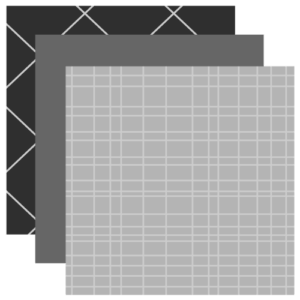
The cover
In addition to the shape of the bed, it is primarily the cover that sets the tone. In terms of cover material, consumers can choose from robust woven fabric, hard-wearing synthetic fibers or high-quality genuine leather, for example. A cover made of light woven fabric, for example, can be well integrated into the country house style. Many models are available in several versions, so interested parties can adapt the bed to an already existing bedroom interior. In addition, the fabric should be breathable to allow cross ventilation of the mattress. Imitation leather restricts breathability, but is well suited for allergy sufferers due to its particularly easy care properties. In addition, there are, for example, climate-regulating fleeces that absorb moisture and wick it away, or covers with a cooling summer side and a warming winter side.

The color
The color selection is not limited to typical colors such as black or brown, but also includes eye-catching trendy colors and color combinations. Especially popular is the color beige, which creates a friendly, welcoming atmosphere. In some cases, the covers also feature intricate woven patterns or embroidery elements that restage the character of the room. Romantic floral designs emphasize the feel-good character, while silver and gold elements accentuate the luxury factor.
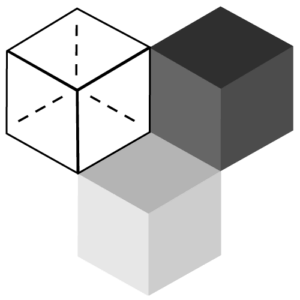
The style
Whether modern, classic or country style, box spring beds come in a variety of sizes and designs, so you can find the right model for any interior style. Lovers of clear, linear shapes and simple colors are best advised with a bed in modern style, so for example, a faux leather cover in anthracite and integrated LED strips. The classic style is characterized by a timeless, elegant design. This includes, for example, a box spring bed with button stitching. Another trend is the country style, which exudes a cozy charm with wood tones and naturally textured fabrics. With shiny fabric and large pillows, on the other hand, the bed looks classy. Simple design, on the other hand, emphasizes the minimalist style.
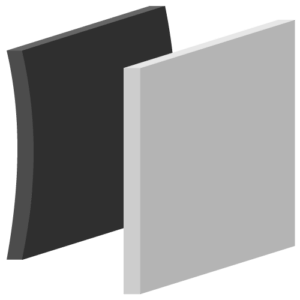
The headboard
An essential decorative element is also the headboard, which can be both strikingly decorated and simple. With a high, upholstered headboard, the bed not only becomes a sleeping zone, but also works well as a place for reading and watching TV. Although most box spring beds have a straight headboard, its edge can also be elegantly curved or interrupted in the middle. It is usually made of solid wood, imitation leather, genuine leather, velvet or fabric. Noble, almost baroque-looking beds are additionally decorated with decorative stones or quilting, while simple variants rely on discreet colors and decorations. Particularly practical are headboards with storage space, which, for example, provides space for evening reading.
Motor, bed base and lighting – extras for even more comfort
Some box spring beds come up with practical extras, such as an integrated bed drawer for additional storage space, a built-in motor for extra comfort or lighting for cozy reading hours. These luxury beds will meet even the highest demands. However, these extras always curtail the original advantage of a box spring bed.
Box spring bed with motor: comfort gain at the push of a button
Motorized box spring beds offer the convenient possibility of continuously adjusting different heights at different positions (head and foot sections) by remote control. Not only can the head be brought into a comfortable position for watching TV, reading or simply sitting upright, but the legs can also be raised, for example in the case of vein problems. This simple adjustment option is especially beneficial to people with back problems and seniors. The disadvantage of a bed with a motor – apart from the higher price – is the reduced air circulation, which favors the formation of mites. So these beds are not suitable for allergy sufferers.
A good motor should have between 5,000 and 7,000 Newton, so that enough power is generated to move the bed including body weight. The headboard should be able to tilt at least 45 degrees, the footboard at least 30 degrees.
Box spring beds with bed base: The practical storage space
In box spring beds with storage space, the box underneath the lying surface is used as storage space. The boxes can usually be opened either at the foot end or at the side. Often they have drawers integrated in the lower bed frame, in which, for example, bedspreads or seasonal clothing can be stored. Box spring beds with a bed base are especially recommended for small bedrooms.
But beware: some manufacturers integrate the bed base directly under the upper mattress and simply omit the lower box spring mattress, so that in the end it is no longer a box spring bed. In addition, in the presence of a bed base, air circulation is no longer possible, which makes this type of bed unsuitable for allergy sufferers, as mites can spread more easily.
Box spring beds with lighting: for atmospheric evenings
Box spring beds with LED lighting provide atmospheric hours. The built-in LED lamps illuminate the bed, providing a stylish alternative to bedside lamps. Narrow light bands, in turn, let the bed shine in a modern light.

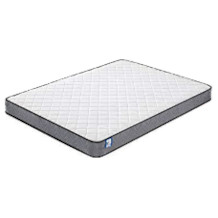
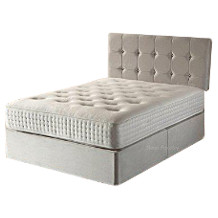
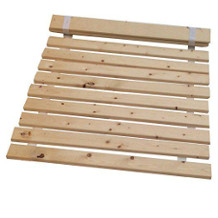


 511 reviews
511 reviews
